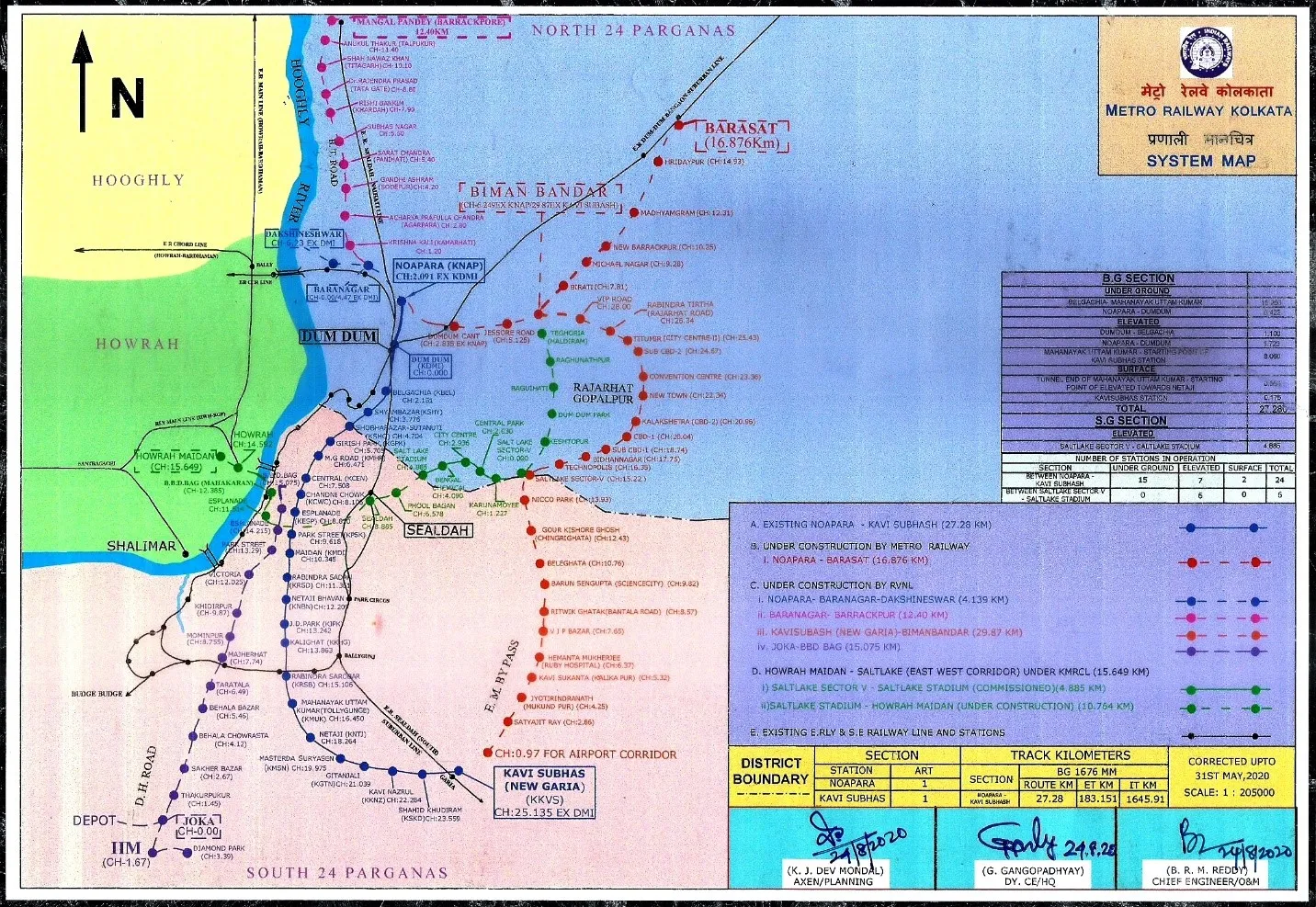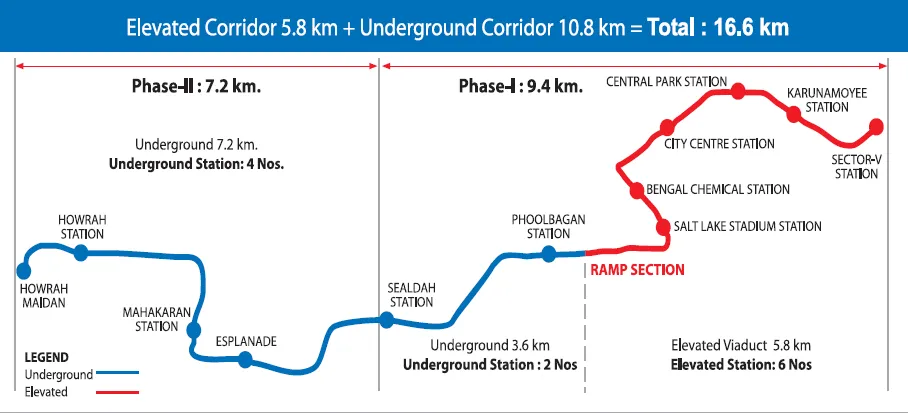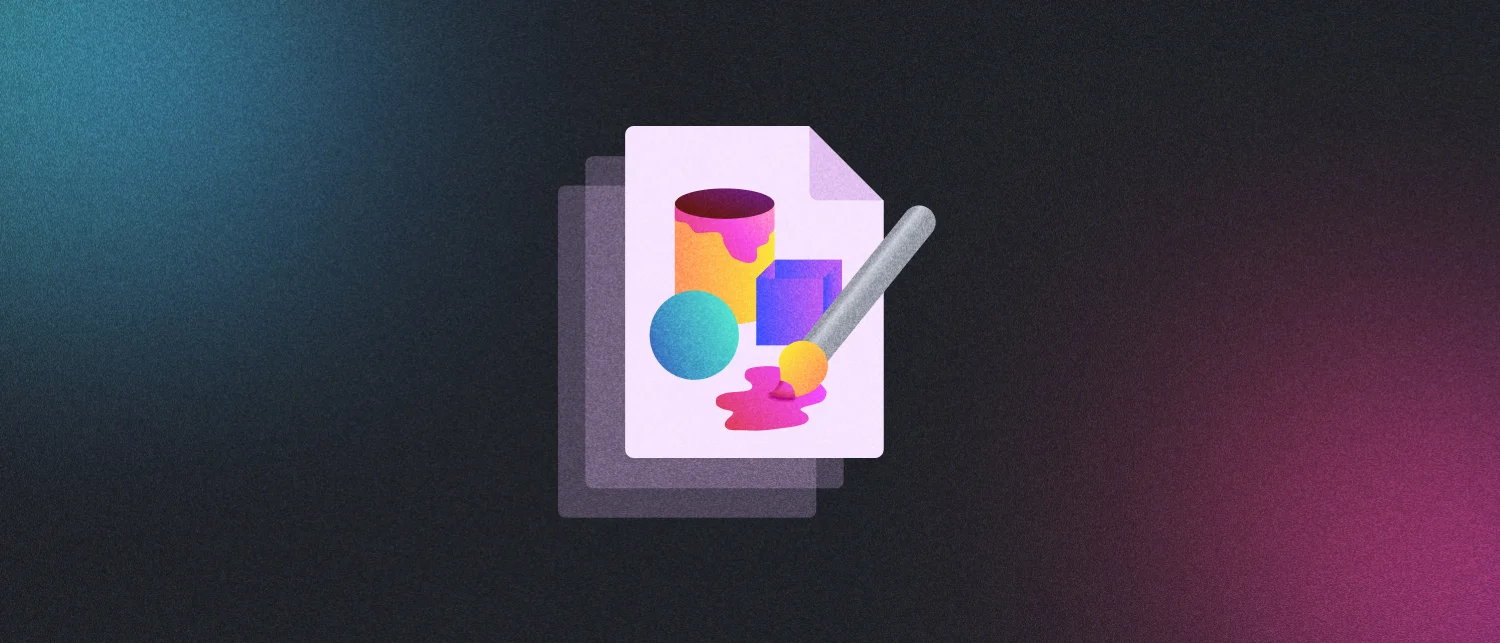Kolkata Metro: A Journey Through Time and Innovation
Kolkata, the City of Joy, holds the distinction of being the first city in India to introduce the metro rail urban mass rapid transit system. The Kolkata Metro began its operations in 1984 and has since evolved into a sophisticated network, thanks to modern technology and new infrastructure. Let’s dive into the fascinating world of Kolkata Metro, with a special focus on the Park Street Metro Station.
The Birth of Kolkata Metro
Kolkata Metro’s journey began in 1984, marking a significant milestone in India’s urban transportation history. The initial phase connected Esplanade to Bhowanipore (now Netaji Bhavan), covering a modest distance of 3.4 kilometers. Over the years, the network has expanded, and today, it includes two operational lines covering around 38 kilometers.
The Underwater Metro Tunnel
Kolkata has achieved another first by constructing an underwater metro tunnel to enhance connectivity. This marvel of engineering is part of the East-West corridor, specifically the Howrah Maidan-Esplanade section. Inaugurated on March 6, 2024, the underwater metro line opened to the public on March 15, 2024. This tunnel, passing beneath the Hooghly River, places Kolkata in the league of cities like London, Paris, and New York, which have similar underwater metro systems.
Kolkata Metro Rail Corporation (KMRCL)
The Kolkata Metro Rail Corporation (KMRCL) is the driving force behind the East-West Metro corridor. On April 12, 2023, Kolkata Metro completed its maiden under-river run through the 520-meter tunnel below the Hooghly River. This achievement connects Salt Lake City with Howrah, with full operations expected by June 2024.
Current Metro Services
As of now, Kolkata Metro operates on two routes:
- North-South Line: Dakshineswar to Kavi Subhas
- East-West Line: Sealdah to Salt Lake
The network is set to expand further with significant budgetary allocations for new projects, including the Dum Dum airport to New Garia and Joka to Binoy Badal Dinesh (BBD) Bagh metro projects.
Recent Inaugurations
On March 6, 2024, PM Modi inaugurated several key sections of the Kolkata Metro:
- Howrah Maidan-Esplanade Metro section
- Kavi Subhash-Hemanta Mukhopadhyay Metro section
- Taratala-Majerhat Metro section (part of the Joka-Esplanade line)
The Howrah Maidan-Esplanade section is particularly noteworthy as it features India’s first transportation tunnel under a mighty river. Additionally, the Howrah Metro Station is the deepest metro station in India.
Quick Facts About Kolkata Metro
| Developed by | Kolkata Metro Rail Corporation (KMRCL) |
|---|---|
| Lines | Six (including two operational lines) |
| Stations | 50 operational, 30 under construction, 18 planned |
| Length | 38 kilometers |
| Timing | 7 AM to 10:30 PM |
| Fare | Rs 5 to Rs 30 |
| Train speed | 56 km/h |
Construction Details
The North-South Metro route from Noapara to Dakshineswar was inaugurated in 2021. Currently, there are four metro lines under different stages of construction. The operational lines include:
- Blue Line: Dakshineswar-Kavi Subhas
- Green Line: Salt Lake Sector 5 to Phool Bagan
- Purple Line: Taratala-Majerhat Metro section (partially operational)
Under-Construction Lines
| Metro Line | Number of Stations | Length (km) | Route |
|---|---|---|---|
| Purple Line | 14 | 16.2 | Diamond Park-Esplanade |
| Yellow Line | 10 | 16.8 | Noapara-Barasat |
| Pink Line | 11 | 12.4 | Baranagar-Barrackpore |
| Orange Line | 24 | 29.8 | Kavi Subash-Biman Nagar |
Park Street Metro Station
Park Street Metro Station is one of the most iconic stations on the Blue Line. Located underground, it serves as a crucial hub for commuters and tourists alike. The station is strategically positioned near several landmarks, making it a popular stop for those exploring the city.
Nearby Tourist Attractions
| Landmark | Nearest Metro Station | Distance from Metro Station |
|---|---|---|
| Indian Museum | Park Street | 0.4 km |
| Victoria Memorial | Rabindra Sadan | 1 km |
| St. Paul’s Cathedral | Rabindra Sadan | 0.8 km |
| Eden Gardens | Esplanade | 1 km |
| Shaheed Minar | Esplanade | 0.8 km |
Kolkata Metro Line 1 (Blue Line)
The Blue Line, also known as the North-South Line, is the oldest metro line in Kolkata. It covers 32 kilometers from Kavi Subhas to Dakshineswar, featuring 26 stations, including 15 underground stations. The line has undergone several extensions since its inception, with the latest being the Noapara to Dakshineswar section in February 2021.
Kolkata Metro Line 2 (Green Line)
The Green Line, part of the East-West corridor, includes 17 stations spanning 22 kilometers. The first phase, from Salt Lake Sector V to Salt Lake Stadium, was inaugurated on February 13, 2020. The line features both elevated and underground sections, with the Phoolbagan Metro station being the first underground station to open on this route.
East-West Metro Route: Underwater Tunnel
The East-West Metro corridor, inaugurated by Prime Minister Narendra Modi on March 6, 2024, includes a 520-meter underwater tunnel beneath the Hooghly River. This 16.6-kilometer corridor connects Howrah with Teghoria, featuring both elevated and underground sections. The Howrah station, located 33 meters below the surface, is the deepest metro station in India.
Kolkata Metro Line 3 (Purple Line)
Currently under construction, the Purple Line will connect Joka in the south to Esplanade in the north, covering around 15 kilometers. The project, developed by Rail Vikas Nigam Limited (RVNL), has faced delays but is expected to enhance connectivity significantly once completed.
Kolkata Metro Line 4 (Yellow Line)
The Yellow Line will connect Noapara and Barasat, spanning 16.8 kilometers. This route is under construction and will feature a mix of elevated and underground stations.
Kolkata Metro Line 5 (Pink Line)
The Pink Line will connect Baranagar to Barrackpore, covering 12.5 kilometers with 11 stations. This line is expected to improve connectivity in the northern suburbs of Kolkata.
Kolkata Metro Line 6 (Orange Line)
The Orange Line will link New Garia with Netaji Subhas Chandra Bose International Airport, covering 29.8 kilometers. This route will provide easy access to the airport, especially for residents of southern and eastern Kolkata.
Kavi Subash – Hemanta Mukherjee Metro Line Stations
| Station Name | Layout |
|---|---|
| Kavi Subhash (New Garia) | Elevated |
| Satyajit Ray (Hiland Park) | Elevated |
| Jyotirindra Nandi (Metro Cash & Carry) | Elevated |
| Kavi Sukanta (Abhishikta Crossing) | Elevated |
| Hemanta Mukhopadhyay (Rubi Area) | At Grade |
Kolkata Metro Map

Source: Metro Railway, Kolkata

*Map of East West Metro Corridor Source: KMRC
Construction Timeline
| Date | Event |
|---|---|
| October 1984 | Oldest metro line connecting Esplanade to Netaji Bhavan inaugurated. |
| September 1995 | 16.45-km stretch from Dum Dum to Tollygunge became operational. |
| February 2009 | Foundation stone for the underwater metro tunnel laid. |
| March 2009 | Construction of the underwater metro tunnel started. |
| October 2010 | 1.58-km stretch from Kavi Nazrul to Kavi Subhash started functioning. |
| December 2010 | Metro Railway granted the status of a Zonal railway. |
| July 2013 | New section from Dum Dum to Noapara became operational. |
| July 2019 | KMRC handed over Line 2 operations to Kolkata Metro Railway. |
| February 2020 | Phase 1 of the East-West corridor from Salt Lake Sector V to Howrah Maidan became operational. |
| October 2020 | East-West Metro corridor extended from Salt Lake Stadium to Phoolbagan. |
| February 2021 | Noapara-Dakshineswar metro route became operational. |
| March 2022 | Kolkata Metro Railway assigned color codes to different corridors. |
| February 2023 | Rs 2,550 crore budget allocated for new metro projects. |
| March 6, 2023 | Howrah Maidan-Esplanade Metro section inaugurated. |
Fare Structure
North-South Line-1 Fare
| Zone | Distance | Fare |
|---|---|---|
| Zone 1 | Up to 5 km | Rs 5 |
| Zone 2 | 5 to 10 km | Rs 10 |
| Zone 3 | 10 to 15 km | Rs 15 |
| Zone 4 | 15 to 20 km | Rs 15 |
| Zone 5 | 20 to 25 km | Rs 20 |
| Zone 6 | 25 to 30 km | Rs 25 |
East-West Line-2 Fare
| Zone | Distance | Fare |
|---|---|---|
| Zone 1 | 0 to 2 km | Rs 5 |
| Zone 2 | 0 to 5 km | Rs 10 |
| Zone 3 | 5 to 10 km | Rs 20 |
| Zone 4 | 10 to 15 km | Rs 30 |
Latest Updates
L-Shaped Subway to Connect Howrah Railway Station with Metro
An L-shaped subway connecting the East-West metro station with Howrah Railway Station is expected to open in June 2024. This will enable seamless movement of commuters without exiting the metro station.
Mahakaran Station on Green Line
The Mahakaran Metro Station on the Green Line opened to the public on December 4, 2023. Located near BBD Bagh, it features modern amenities and caters to high passenger demand.
Network Expansion Plans
The Kolkata Metro network aims to cover 100 kilometers by 2026, including the Joka to Esplanade and New Garia to Kolkata airport sections.
Mobile Application
The Metro Railway Kolkata offers a mobile application available on the Play Store. It provides information on metro fares, nearest stations, train timings, and smart card recharge facilities.
Token and Smart Card
Commuters can use tokens for single journeys or opt for smart cards, which offer a 10% bonus on recharges. The smart card can be recharged online through the Metro Ride Kolkata app or the official recharge portal.
Real Estate Impact
The expansion of the Kolkata Metro has significantly enhanced connectivity, leading to increased commercial developments and a rise in property demand along the new routes.
Interesting Facts
- Kolkata Metro is the oldest metro route in India.
- It has the least fare in the world.
- Ten stations are named after famous Bengali personalities.
- It can cater to over five lakh passengers daily.
- It features India’s first underwater metro tunnel.
Contact Information
For any queries, commuters can contact:
- Address: Kolkata Metro Rail Corporation Ltd, HRBC Complex, KMRCL Bhawan 2nd and 3rd floor, Munsi Premchand Sarani, Kolkata – 700021
- Phone Number: 66071117
- Email: gm.admin@kmrc.in

Source: Metro Railway, Kolkata

*Map of East West Metro Corridor Source: KMRC
The Kolkata Metro continues to evolve, offering enhanced connectivity and convenience to its commuters. With ongoing expansions and technological advancements, the future of Kolkata Metro looks promising, making it an integral part of the city’s urban landscape.
